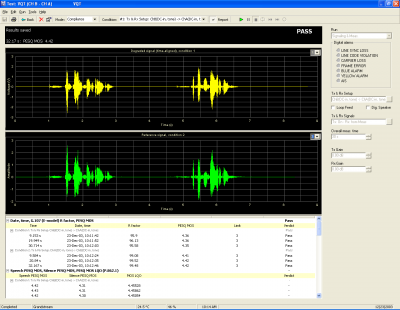TCA 8200
Voice Quality Testing (VQT)
The VQT provides a software option for Hermon Laboratories TCA. Voice Quality Testing (VQT) utilizes PESQ (Perceptual Evaluation of Speech Quality) algorithm to assess the voice quality of telecom equipment and networks.
The PESQ algorithm, defined in the ITU-T P.862 recommendation, models human perception of speech, by comparing a reference speech signal with the “degraded” signal. The reference signal is transmitted by the test instrument to the EUT (Equipment Under Test) and the degraded signal, output by the EUT is measured by the test instrument.
The most eminent result is the ITU-T P.862 PESQ MOS (Mean Opinion Score), it directly expresses the voice quality. The PESQ MOS ranges from 1.0 (worst) up to 4.5 (best).
Additional results such as Delay and Delay Jitter, G.107 rating R factor, various waveforms, level, gain, loudness, SNR, VAD (Voice Activity Detection) parameters – Front End Clipping, Hold Over Time and Drop outs are also provided.
Typical applications of VQT are VoIP, PSTN, ATM networks, Frame Relay, wireless equipment, and networks and handset and speaker phones. Of particular interest is speech quality assessment and analysis of compression and VAD codec’s such as those used in VoIP and wireless networks.
PESQ VQT can replace an array of lengthy “traditional” TIMS voice frequency measurements.
PESQ evolved from the need to automate the human listening tests (as defined in ITU P.800) and has introduced improvements to the older PSQM+, PSQM and PAMS methods.
The VQT measurements can be performed on any combination of the following TCA 8200 Tx – Rx ports: Analog, Acoustic, T1, E1, VoIP Ethernet except for T1-E1 and E1-T1 combinations. With TCA 4100, only Acoustic and VoIP cobminations are available. The analysis can be performed on-line and off-line (comparison of pre-recorded files).
Received voice signals can be recorded to wav files.
Key Features:
- PESQ MOS per ITU-T P.862
- POLQA MOS per ITU-T P.863
- Codec VAD testing
- Delay and Delay jitter
- Fully automatic measurements with built-in signaling
- Automatic reading/recording from/to one or auto-incremented files
- On-line and off-line analysis
- Real-time display of results and degraded versus reference waveforms
